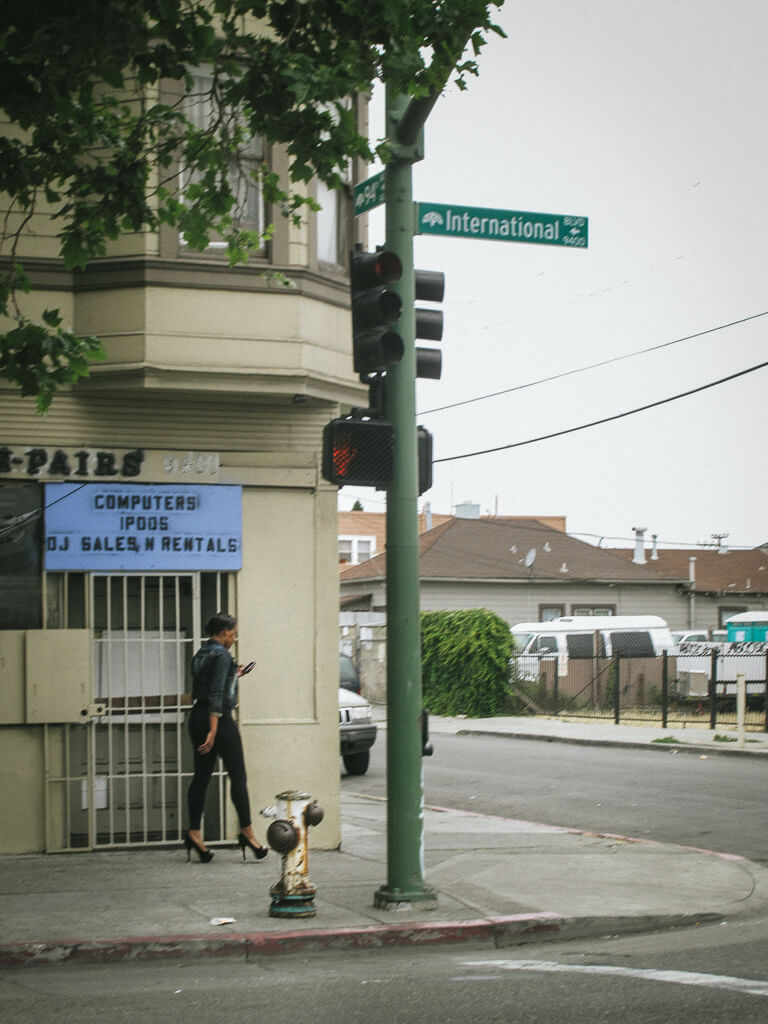By Lynsey Clark
As child trafficking problem intensifies community finds new ways to combat the problem.

A storefront on International Blvd provides a glimpse into the attire worn on the track. Photo: Lauren Gonzalves
Members of the Oakland police force sit on metal chairs scattered throughout a conference room, with badges and handcuffs clipped to their hips. Government officials donning dark suits, and caseworkers clutching scratch pads also crowd the room. Sergeant Holly Joshi, Supervisor of the Police Department’s Child Exploitation Unit, marches up and down the aisle in a blazer and red sneakers, speaking loudly and quickly.
“Oakland is at the forefront of the fight against modern day slavery,” she says decisively, adjusting her pink-rimmed glasses, hair wound tightly in a bun.
The city of Oakland has one of the highest rates of child trafficking in the state. Alameda County’s District Attorney’s office prosecutes 46 percent of all of California’s cases with an 80 percent rate of conviction. A large part of the county’s success in combating the problem can be attributed to its approach and collaboration with other agencies.
In the face of budget cuts, a loose confederation of governmental agencies and non-profits have fought increasing rates of child trafficking while developing strategies to work through the trauma experienced by victims of exploitation. Laws that place exploited minors in the juvenile justice system as opposed to foster care typify the systemic barriers that these advocates face. But in Oakland, where obstacles abound, dedicated professionals are finding a way to regain ground.
The Oakland Police Department (OPD), the DA’s office unit on Human Exploitation and Trafficking (H.E.A.T.), and local non-profits, work together against child trafficking. They share information as it develops, then present it to the public at conferences like this one: Points of Entry for Sexually Exploited Minors. It was the ninth Bay Area Coalition Training, hosted by H.E.A.T., in a large nondescript conference room downtown: almost every chair filled.
The Federal Bureau of Investigation (FBI) has designated the Bay Area as a “high intensity child prostitution area” and law enforcement officials estimate that 100 children are sold for sex on a given night. Oakland is at the epicenter of the problem with more known underage girls and more pimps than almost any other city in the state.

Those who work on International Blvd often make eye contact with passing cars to solicit potential clients.
Photo: Lynsey Clark
There are a variety of factors that contribute to the problem including one of the longest “tracks” in the country. The track refers to a strip of International Boulevard that is known for prostitution. “It goes all the way from 1st Avenue to 109th,” Joshi explains. “It’s also one of the most dangerous tracks in the country.”
The track covers a wide stretch of Oakland and parts of neighboring San Leandro. Dingy motels and hotels crop up along the track, boasting hourly rates from their street signs. Two of them so blatantly welcomed the sex trade that a judge shut them down last year, fining each $45,000.
The OPD has been involved with this issue for twelve years now and was one of the first counties in the nation to form a human trafficking unit. But there’s only so much the department can do with limited resources and increasing numbers of trafficked children.
Despite the immensity of the problem OPD’s ranks have steadily dwindled as a result of the economic downturn that has significantly impacted the city’s resources and programs. The force has decreased by 27 percent since 2009 as a result of budget cuts.
A year ago vice was disbanded in order to free up officers and supplement other divisions, a source close to the OPD said in an email. After the department laid people off and instituted a hiring freeze, most specialized units were eliminated (or depleted to the point of functional irrelevancy) to staff for patrol services, internal affairs and criminal investigations.
“As would be expected, the totally unchecked track proceeded to go bananas and become more intractable than ever,” the source wrote. “Now, the reinstated unit, just three officers and a sergeant, has a genuine quagmire to contend with.”
It was never a huge unit and now it has been cut in half. “I would be lying if I didn’t say the amount of resources and police involvement didn’t impact outcomes,” Joshi says. “But I also can’t complain because patrol officers are in the same situation. It’s difficult for me to demand resources when everyone is in the same boat.”
Complicating the problem is the increased rates of gang involvement in child trafficking in the city. The gangs have switched from selling drugs and guns to selling underage children for sex, according to Hatzune Aguilar-Sanchez, who works on the issue for Oakland Mayor Jean Quan. “It is much more difficult to gather evidence, and make convictions; and the consequences are not nearly as steep for ‘pimping’ as they are for drugs. Making it even worse, our society has largely glamorized the exploiters.”

On the same boulevard that OPD patrols for trafficking, there are elementary schools and churches.
Photo: Lauren Gonzalves
For the young girls who are trafficked, traumatic histories may contribute to the cycle if exploitation. “Exploiters actively seek out group homes and shelters to recruit vulnerable children,” a recent report entitled Ending the Commercial Sexual Exploitation of Children, notes. The report was authored by The Child Welfare Council, which serves as an advisory body for agencies that serve the children in the child welfare system in the state. The rapid increase of sexually trafficked children in the state prompted the publication of the report, which outlines risk factors for exploitation, including alarmingly high rates of foster kids (50-80 percent).
More than 75 percent of CSEC experienced child abuse or neglect, often trauma is experienced as a chronic condition of their childhood, including severe or repeated episodes of neglect. According to the report the most important factor identified is age. Exploiters target younger children because they are easiest to manipulate and deceive. Additionally, most CSEC have a history of emotional, physical, or sexual abuse that contributes to their vulnerability. The average age of a commercially sexual child is 12, three years younger than the average age was ten years ago.
The West Coast Children’s Clinic, a private, non-profit children’s psychology clinic, has tailored treatments specifically for CSEC in order to curb the traumatizing effects of commercial sexual exploitation. At their office one block off the track, Dr. Danna Basson, director of research and evaluation, discussed the work in a small meeting room with toys gathered in loose piles in the corner. “The work is often focused on getting them to understand their exploitation,” Basson explains.
Many CSEC do not identify as victims and often demonstrate trauma bonding with their exploiters. West Coast conducted a study of CSEC in Alameda County and found that fewer than half of CSEC recognized their pimp or exploiter as not operating in their best interest. “We do see improvements over time, but it is very intensive and it takes a long time.”
The emotional, and mental health repercussions from sexual exploitation are staggering. Their report found that 84 percent have problems with judgment that place them at risk of significant physical harm, including severe substance use (31 percent). Children who have been commercially sexually exploited also demonstrate various problems in adulthood including self-harming behavior and serious mental illness.
Dr. Basson explains one of the largest systematic challenges of providing services to CSEC is that the child welfare system is not explicitly designated as the system to respond to sexual exploitation. If that were changed on a legislative level services would become more readily available for the youth. “There are procedures to deal with child abuse,” Basson explains. “Social services could provide the consistent protective response necessary if it was designated to do so.”
Advocate agencies have long rallied for the expansion of the child welfare’s jurisdiction to include sexually trafficked children. They believe child welfare’s focus on addressing abuse and neglect is especially relevant to the needs of victims of trafficking. Currently, children who have been trafficked are processed through juvenile delinquency court, which tries cases involving children who have committed crimes.
Though sexual exploitation has yet to automatically fall under the prevue of social welfare, non-profit organizations have sprung up throughout Oakland in response to the epidemic. One of them is MISSSEY, or Motivating, Inspiring, Supporting and Serving Sexually Exploited Youth, which formed in 2007 to provide direct services to trafficked youth and trainings for community members.
“We are a survivor and peer led organization,” Joy Massey lead case manager at MISSSEY explains. “The idea is that these girls can come in and receive services from people who understand what they have been through and who are sensitive to their issues.”
MISSSEY provides services that include case management, resource services, and a drop-in recovery center. “We do anything from finding housing to helping someone get an ID,” Massey explains. “Because that’s part of the exploitation process, taking away any identification of who they are. Getting it back is a part of helping them recover.”
Though Massey believes specific needs are important she also thinks there are large challenges ahead. “We need to stop accepting it as a community in Oakland,” she stated. “There has to be a cultural shift, we can’t turn our eyes away from this issue anymore.”
Sargeant Joshi says she and her department are unwilling to let these obstacles thwart the Child Exploitation Unit efforts.
“What we have to do is try to be smarter with the resources that we have. And really work hard and be intelligence based.”
She does have some good news. The OPD and FBI are forming a CSEC task force. The two agencies already have a positive working relationship; an FBI agent accompanies the unit out on cases. The new task force will employ a fulltime FBI agent working out of the building. “Instead of it being ‘lets talk once a week and share intelligence’ it’s everyday collaborating on cases,” Joshi explains.
Despite the tactical obstacles and funding barriers, Joshi never loses sight of her target: how to assist children who have abused. “What I see as the biggest challenge in Alameda County,” Joshi say, “ is what are we going to do with the girls that we know are victims? We are working with a system that is not set up to deal with this kind of crime. How do we keep that girl alive?”
Lynsey Clark is a second year student at UC Berkeley’s Graduate School of Social Welfare and is a summer fellow in Fostering Media Connection’s Journalism for Social Change program.






